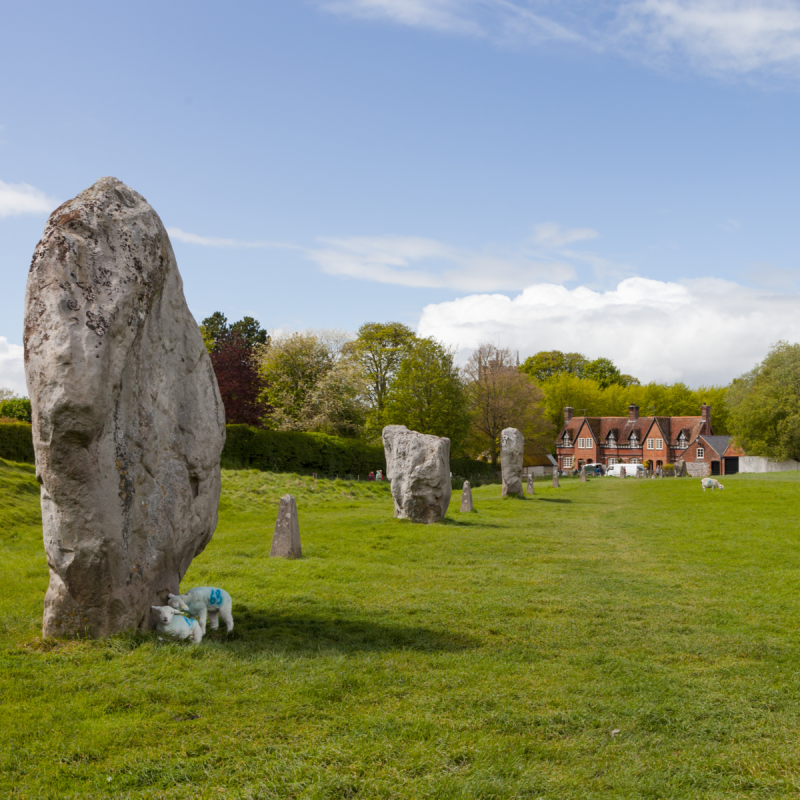
(Photo Credit: Paulina Grunwald / Shutterstock.com)
The link between Neolithic stone circles and the celebration of the summer solstice goes back millennia. When the sun rises on the longest day of the year, the rays of the sun line up so perfectly at Stonehenge — indubitably the world’s most famous stone circle — that they hit the altar stone, which made archaeologists and historians wonder if indeed Stonehenge was built purely to celebrate that one day of the year.
Videos by TravelAwaits
While the ancient druids lost their influence over the millennia, the 1960s and 1970s saw a revival of the (maybe slightly drug-fueled) celebration of the summer solstice. So much so that the famous 5,000-year-old monument had to be closed to the public, particularly on that day.
Since reopened but with a barrier in place, Stonehenge is still the place to celebrate the arrival of summer, but there are also plenty of other stone circles that are truly impressive, and certainly draw a lesser crowd. In fact, on the British Isles alone, more than 1,000 stone circles have been listed.
Whether summer solstice or not, here I would love to introduce you to some other stone circles, all steeped in mystery despite historians’ best efforts. The not-knowing adds to the magic of them, and there is absolutely no doubt that you do feel in awe when you see the stones, be they the huge Stonehenge stones or their smaller cousins.
The simple fact of their enormous age, the people long-gone that worked so ingeniously putting the monuments up, and the history these stones have been part of is mind-blowing. Whether you’re a druid, hippy, solstice enthusiast, or simple traveler, all the stone circles mentioned here that are found on (nearly) every continent are worth seeing any time of the year. But if you happen to find yourself nearby when the first rays of the longest day of the year emerge, then that is even more special.

(Photo Credit: John Kotlowski / Shutterstock.com)
1. Stonehenge
England
Standing tall on Salisbury Plain in Wiltshire, some 10 miles from the lovely city of Salisbury, is the most famous of all stone circles in the world: Stonehenge. The name Stonehenge is thought to come from the Saxon stan-hengen, roughly translated as “stone hanging” or even “gallows.”
Today, “henge” is used to denote a (stone) circle. Stonehenge consists of 43 vertical shaped standing stones, each around 13 feet high, 7 feet wide, and weighing in at around 25 tons. They originate from the Welsh Preseli Hills more than 140 miles away. The exact origin and purpose of this incredible feat of building are still unknown, but the fact is that it is the most popular place to celebrate the summer solstice, with the sun lining up perfectly with the stones.
Pro Tip: Don’t miss Woodhenge next door to Stonehenge, a Neolithic henge of wooden stumps, which is just as intriguing as the stone version.

(Photo Credit: Paulina Grunwald / Shutterstock.com)
2. Avebury
England
Avebury Henge may not be as famous as Stonehenge but is just as interesting, especially considering that the more naturally-shaped stones stand within a village setting — and not all on their own — making a trip there a bit more varied, with more to see and even lunch to be had. Avebury’s henge is in fact older than Stonehenge, and part of an entire set of Neolithic and younger sites that can be explored on a walk covering standing stones, burial mounds, an Anglo-Saxon road, and also lovely countryside.
Pro Tip: Don’t miss the Alexander Keiller Museum on site, detailing the history of the discovery of the stones in the 1930s.

(Photo Credit: travellight / Shutterstock.com)
3. Carnac Stones
Brittany, France
In southwestern Brittany stand France’s most famous stones, the Carnac Stones. 88 miles from Nantes along the coast, these stones are part of an entire expanse of stone sites, dating back some 7,000 years. This is one of the most important prehistoric sites in Europe, with speculations as to the purpose of the circles, alignments, and single monoliths ranging from religion to basic earthquake indicators to astronomy. Nobody knows for sure. The fact is, though, that there are not only 3,000-odd stones, but also ancient tombs and more, making this an impressive sight to see.
Pro Tip: Not far along the coast you will find the Cairn de Gavrinis, another megalithic monument with incredible decorations, all set before the beautiful Bay of Morbihan with its rugged coast and islands, making this area perfect for a summer (solstice) break.

(Photo Credit: U. Eisenlohr / Shutterstock.com)
4. Filitosa
Corsica, France
This megalithic site on the southwestern edge of the French island of Corsica, just north of the Italian island of Sardinia, offers not a stone circle, but menhirs with a little something extra. Think of Easter Island and you are getting warmer than thinking of Stonehenge. Here, the standing stones have been engraved with faces and swords. Shaped and sized not unlike other prehistoric stones, the decorations found here are more pointing toward a defense function, even though ceremonial and worship functions have not been excluded.
Pro Tip: There is no hint as to this site having been used in summer solstice celebrations, however, visiting the nearby Strait of Bonifacio at sunset is something not to be missed.

(Photo Credit: Wirestock Creators / Shutterstock.com)
5. Australian Standing Stones
New South Wales, Australia
Not 1,000s of years old, but merely a couple of dozen, the Australian Standing Stones in Glen Innes stand under tall eucalyptus trees in northern New South Wales, roughly 150 to 200 miles inland from the beach resorts of Coffs Harbour and Byron Bay. This young monument was put up in the 1990s as a tribute to the many settlers from Ireland, Wales, Cornwall, Scotland, the Isle of Man, and Brittany, bringing their Celtic heritage with them. And part of that Celtic heritage is the celebration of the summer solstice, so every solstice day, a ceremony takes place complete with bagpipes, traditional ceremonies, lectures about the stones and their relation to the sun, and plenty of merriment.
Pro Tip: The town of Glen Innes is brimming with heritage and culture, so an overnight stay — maybe before heading to the coast — is well worth it.

(Photo Credit: Vladimir Zhoga / Shutterstock.com)
6. Wassu Stone Circles
The Gambia
Stretched across an area roughly 250 miles long and 62 miles wide in the Senegalese region of Western Africa, reaching across both Senegal and the Gambia, lie an astounding 1,000 stone circles and burial mounds. The Wassu Stone Circles are one of four main sections of this vast UNESCO World Heritage Site and are home to 11 stone circles, plus a museum giving some of the history behind the many digs in the area. While the exact purpose of these stone circles, dating back “only” 1,500 years is still unknown (as is so often the case), the presence of many burial mounds suggests a ceremonial purpose with regard to burial rituals.
Pro Tip: Unless you are on a road trip, it is probably easiest to visit the stone circles on a tour, which also takes travelers to Georgetown.
7. Mystery Hill
New Hampshire, U.S.A.
Another continent, another mystery. Mystery Hill, the American Stonehenge is thought to date back some 4,000 years, but who built it is open to debate. Native American cultures or early European migrants such as Vikings? Nobody knows for sure. But the site is, like all the others, fascinating, partly because of the many unknowns. Unlike the other stone circles, here there are no actual stone circles, but single standing stones together with walls built from granite slabs and what looks like buildings or rooms made from rocks, suggesting some sort of habitation or early settlement. Don some sturdy walking boots and you’ll find the first stones roughly 10 minutes from the visitor center.
Pro Tip: In this spot, you can actually celebrate the summer solstice with a sunset drum circle held every June 21.

(Photo Credit: AlicanA / Shutterstock.com)
8. Gobekli Tepe
Anatolia, Türkiye
What is thought to be the oldest stone circles in the world can be found at Gobekli Tepe in Anatolia in southwestern Türkiye, some 6 miles from Urfa. Predating Stonehenge by an incredible 6,000 years, making them 11,000 years old, Gobekli Tepe is one of the world’s most astounding archaeological sites. Some suggest that it incorporates the world’s oldest temple, putting the ancient Egyptians truly to shame. Many stone circles with 7-ton shaped stone pillars stand practically untouched, while other standings stones have been moved over the years to clear areas for farming and building. Data has shown that many circles were built on top of other circles covered with dirt, making them several stories deep. Again, the original purpose is even more unknown than in the other cases, but engravings of various animals suggest a hunting connection.
Pro Tip: There are numerous tours to this important site, most setting off from Urfa.
Honorable Mentions
- The Deer Stones in Mongolia are Bronze Age standing stones engraved with images of deer.
- In Costa Rica, you can find unusual stone spheres accredited to the pre-Columbian peoples.
In Washington, in the Maryhill Museum there stands a replica of Stonehenge, which is somewhat unlike the original, but still imposing.
